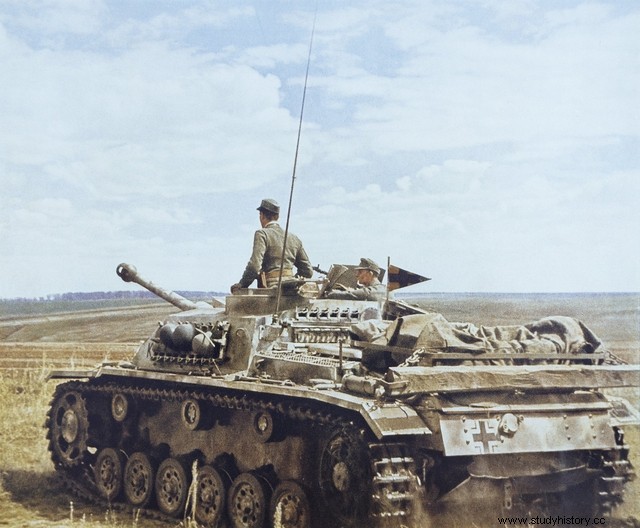- The Second World War gave rise to confrontations mobilizing an industrial capacity never seen before. The combat tanks developed during the First World War have been greatly improved. Similarly, aviation is increasingly suited to offensive missions behind enemy lines.
- Germany is learning the lessons of the First World War, the defeat then was largely caused by an economic blockade in the context of a war of positions. It is therefore a question of quickly penetrating the enemy lines in order not to allow an encirclement to take place.
- Strategies concerning the use of armor differ between France, which has remained on the model of a war of position despite the warnings of Charles de Gaulle, as shown by the construction of the Maginot line, and the Germans who wish to reconnect with the war of movement in order to avoid an encirclement.
- General Heinz Guderian therefore developed an offensive strategy called the Blitzkrieg which consists of a concentration of armored units on a point of the front line allowing a breakthrough in the enemy defensive system. The troops are then able to move quickly in order to proceed to the encirclement of enemy troops or the destruction of strategic objectives. The goal is to quickly undermine the opponent's abilities and command.
1940 - 1942

Characters
Heinz Guderian
Charles de Gaulle
Georgy Zhukov
Procedure
This tactic was a success in the first two years of the conflict and made it possible to subjugate Poland as well as France in a few weeks. On the French side, the offensive began on May 10, 1940 by bypassing the Maginot Line and ended on June 22, 1940. This also caused the encircled troops to be imprisoned, which gave Nazi Germany a means of pressure supplement with the French authorities.
The Wehrmacht has thus managed to impose itself despite less substantial technical means.
This method seems to be a success during Operation Barbarossa which began on June 22, 1941, allowing rapid progress which brought the Wehrmacht near Moscow from October 1941. However, the onset of winter rendered the equipment inoperative and caused the reflux of the German army. The Wehrmacht having failed to strike the Soviet command center or its industry, the dynamism necessary for the Blitzkrieg is broken and the Soviet counter-offensive led by Zhukov resumes the principles of the Blitzkrieg in deep operations.
Consequences
The development of this military strategy allowed Germany to quickly take possession of many territories, but the emergence of resistance movements and the succession of defeats on the Eastern Front from 1942 put an end to their progress.
